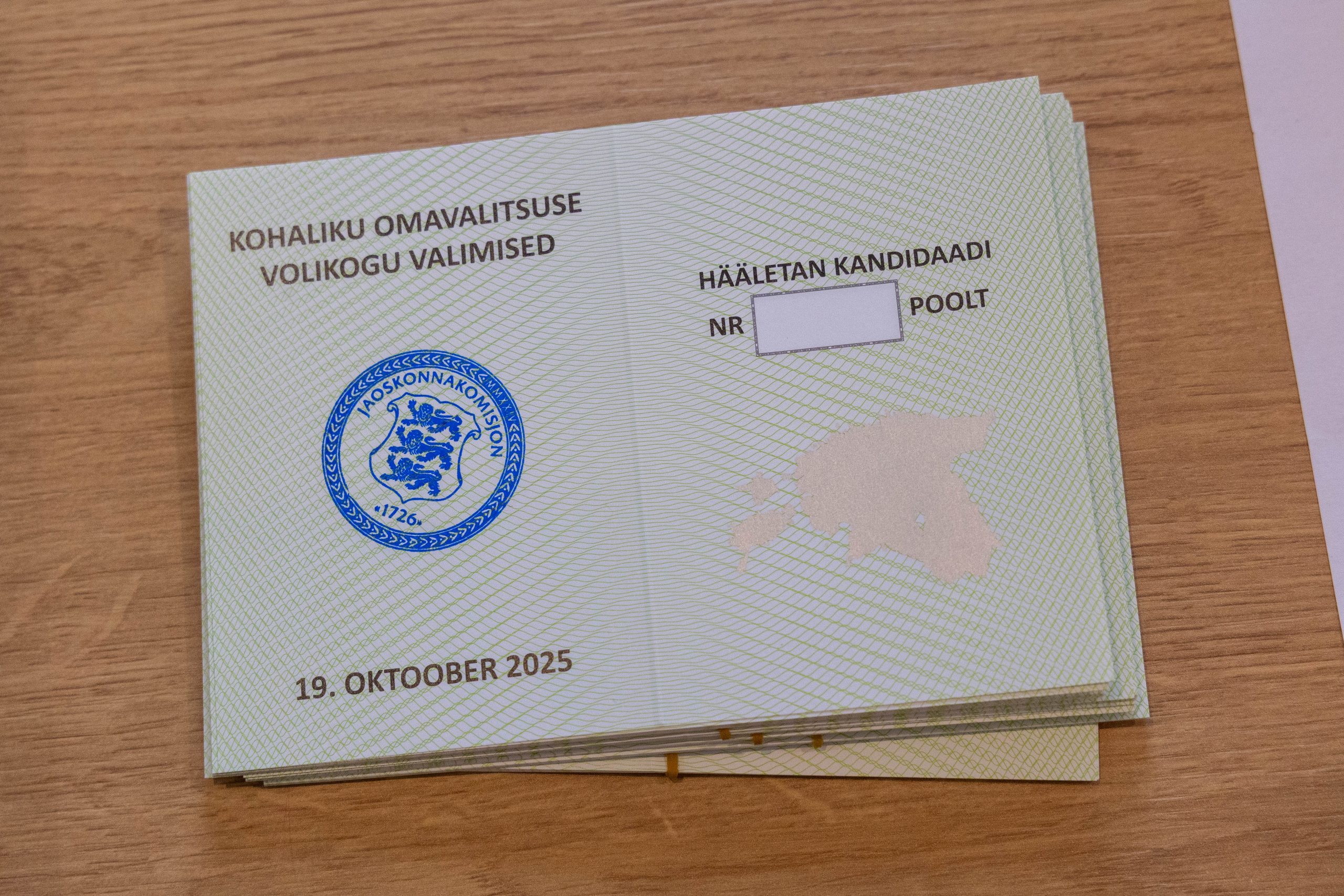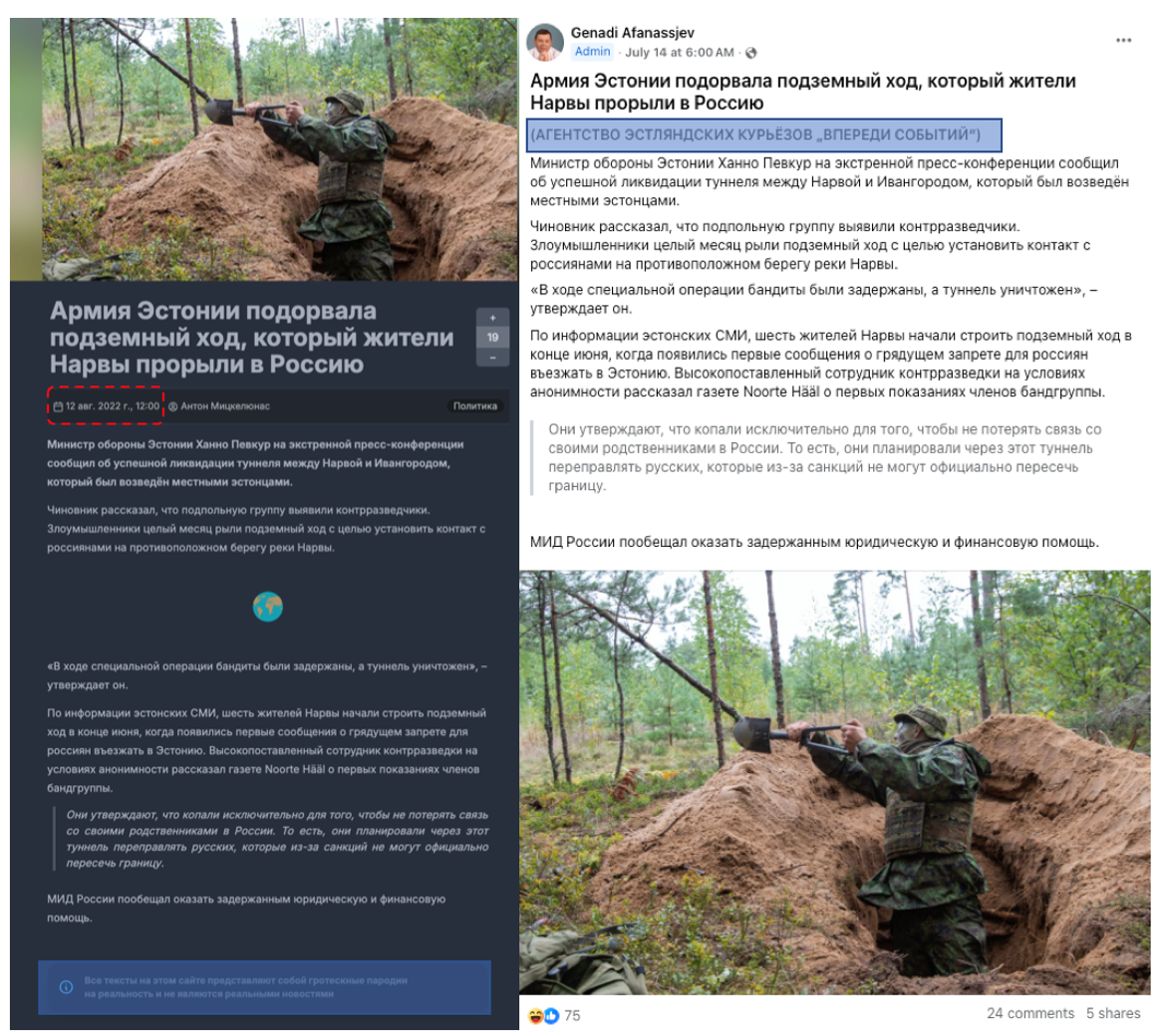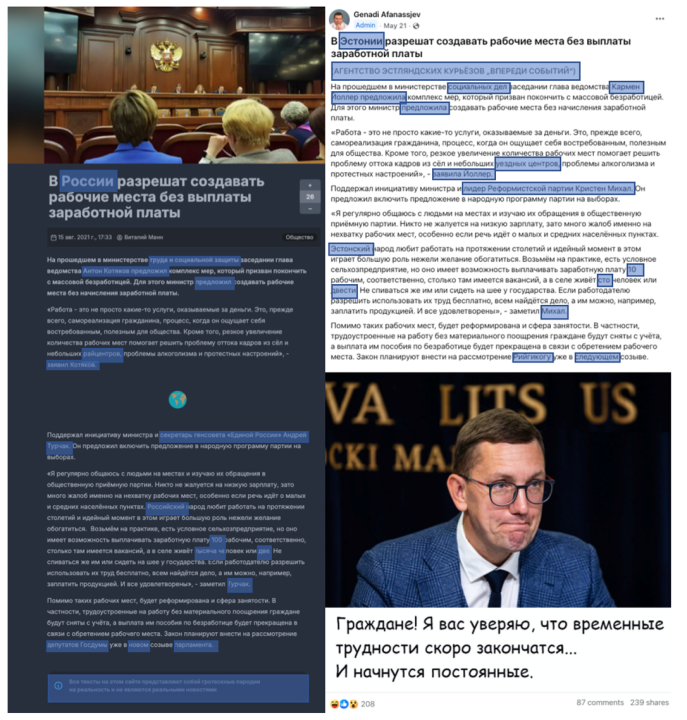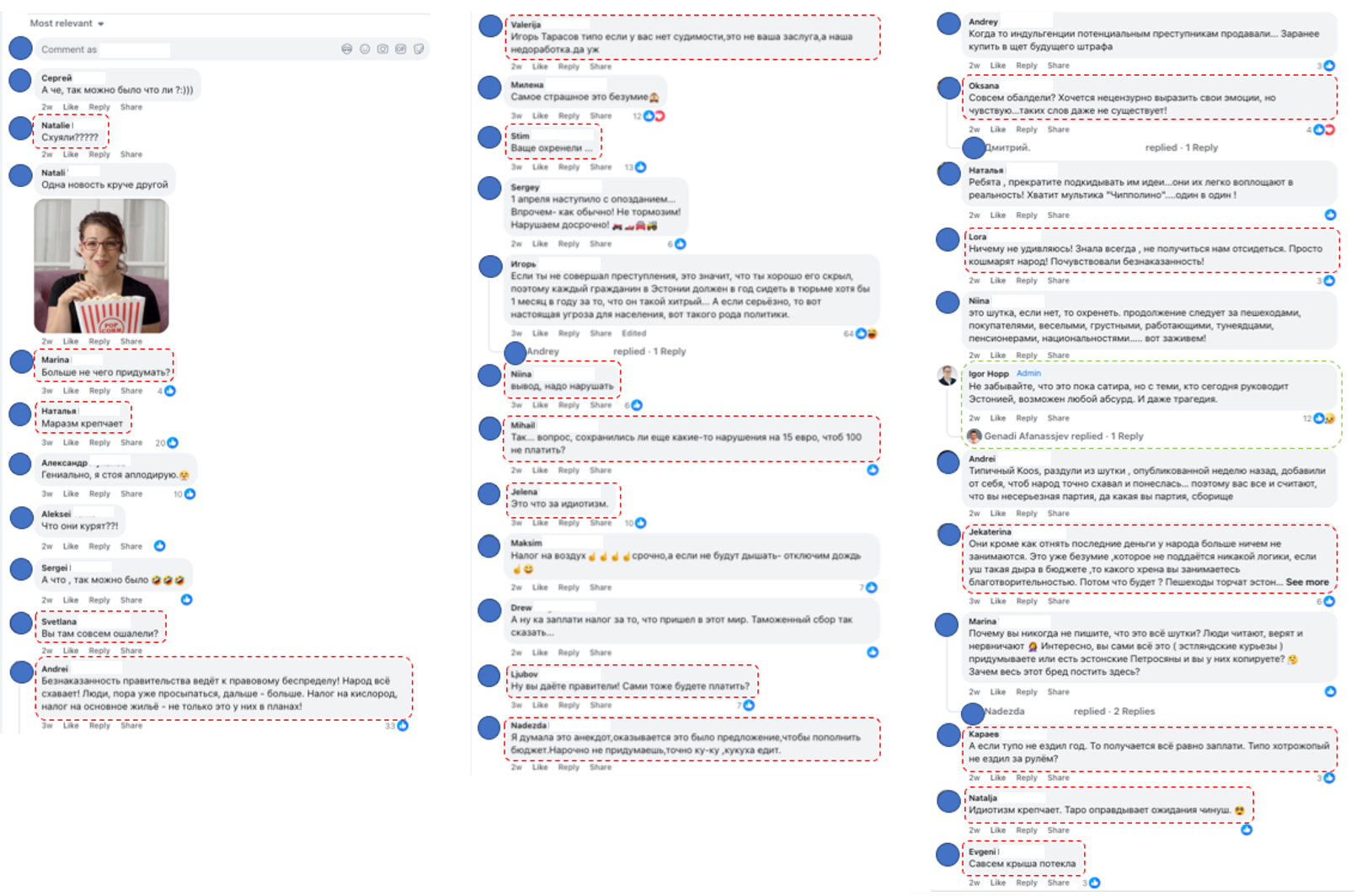Pro-Kremlin politician weaponizes satire to engage Russian population in Estonia ahead of local elections
The posts lack a clear disclaimer indicating that they are satire and are often perceived as real news, portraying the current Estonian government in a negative light.
Pro-Kremlin politician weaponizes satire to engage Russian population in Estonia ahead of local elections

BANNER: Advance voting started on October 13 for Estonia’s local elections. (Source: Reuters/ Dmitri Kotjuh, Järva Teataja)
A pro-Kremlin politician in Estonia, Genady Afanasyev, is adapting and constructing narratives from a satirical Russian website that he disseminates in Facebook groups, where some users appear to accept them as fact. This activity has been ongoing since April 2025 and represents an attempt to sway the Russian-speaking population in Estonia to anti-government sentiments ahead of local council elections on October 19.
Afanasyev served as the Deputy Mayor of Narva in 2001 and later as a member of the Narva City Council from the Russian Party in Estonia (Vene Erakond Eestis – VEE). He was vice-chairman of the party until 2012, when it merged with the Social Democratic Party (Sotsiaaldemokraatlik Erakond – SDE). The Russian Party was known for organizing World War II commemoration events and participating in international initiatives aimed at representing the interests of Russians in Estonia.
In Estonia’s local elections, Afanasyev is running for office in Narva as candidate number 190 on the list of KOOS, a political party known for its pro-Kremlin stance. He is the admin of two Facebook groups affiliated with the party KOOS (the “Koos – Narva” group since January 21, and the leading “KOOS” Facebook group since February 5).
KOOS (“Together” in Estonian) is a pro-Kremlin political movement and a registered political party as of May 2023, also known as “TOGETHER the organization that points out sovereignty” (“KOOS organisatsioon osutab suveräänsusele”). It emerged as the KOOS/Vmeste political party, founded in May 2022 by Aivo Peterson (born Aivo Krõlov) and Oleg Ivanov. Both Peterson and Ivanov have previously denied the Bucha massacre in Ukraine and expressed other hardline pro-Kremlin positions. Peterson is currently detained and facing trial for treason against Estonia, accused of attempting to set up “an anti-state armed militia” group after receiving instructions from individuals connected to the GRU, Russia’s military intelligence agency. Fearing similar prosecution in Estonia, Ivanov fled to Russia in May 2023 and was expelled from the party.
As observed by Propastop, a local blog that exposes pro-Russian influence and is run by volunteers of the Estonian Defense Union (Kaitseliit), Afanasyev posts dozens of times a day in the KOOS Facebook group. Most of these are reposts from real media outlets or pro-Kremlin Estonia-focused Telegram channels. The content discusses elections in Estonia, NATO and the war in Ukraine, global political affairs, and other miscellaneous topics. Afanasyev’s posts, made on his Facebook profile, on the main KOOS Facebook group, and the Koos – Narva Facebook group, frequently include the banner text “Agency of Estland Curiosities.” The DFRLab analyzed 104 posts published on the main KOOS Facebook group between April 30 and July 27 that mention the banner text. Eighty of 104 (76.9 percent) of Afanasyev’s posts in the KOOS Facebook group were adapted content from Panorama.pub, a Russian satirical website, similar to The Onion. While Afanasyev primarily operated on Facebook, twenty-five of his posts were reposted by other users on VK, the Russian analog of Facebook, six on Telegram, three on TikTok, one on YouTube, and one on X. In some cases, the satirical stories were presented as real news and garnered significant engagement.
Content adaptation
Afanasyev began posting repurposed satire to the KOOS Facebook group on April 20. The large majority of his posts were sourced from Panorama.pub. The website contains a warning message at the bottom of each article stating, “All texts on this site are grotesque parodies of reality and are not real news.” Other frequently cited sources were Russian-language Estonian media outlets, such as rus.Delfi.ee, rus.Postimees.ee, the Kremlin-aligned media outlet RBC, and the Russian forums Yaplakal and LiveJournal. The DFRLab was unable to identify the source for sixteen of 104 posts.
Afanasyev copied stories about Estonia verbatim while adding the “Agency of Estland Curiosities” header and disregarding the warning included in the original satire article.

In cases where the story was not directly about Estonia, Afanasyev localized the story to the Estonian context by changing the names of places, people, institutions, the scale of the country, and other details. For example, one post (below) suggested that Estonia would introduce payless jobs, but the original article on Panorama.pub satirized the idea that the action would be taken in Russia. The image used in Afanasyev’s post shows Kristen Michal, the Estonian Prime Minister. The text below the image reads “Citizens! I assure you that temporary hardships will end soon… And permanent ones will begin.” The story is an example of the documented “economically failed state” Kremlin propaganda narrative commonly circulated in relation to Estonia and other Baltic states.

In some cases, an additional effort was made to adapt images by substituting characters’ faces with faces of known Estonian politicians. Below is an example of Estonian Prime Minister Michal edited into an image from Panorama.pub.

User Engagement
The KOOS Facebook group was created on April 9, 2022. It had 7,660 members at the time of writing, including ten group administrators/moderators, over half of whom have a public affiliation with the KOOS party. The engagement of KOOS group members with Afanasyev’s post containing the “Agency of Estland Curiosities” header was minimal. On average, such posts garnered 43 reactions, 15 comments, and 12 shares.
The narrative concerning unpaid jobs was the most engaged-with post by Afanasyev in the group (208 reactions, 87 comments, 241 shares), followed by a post alleging that “Marinating meat at home has been banned in Estonia” (115 reactions, 75 comments, 174 shares), and a post suggesting that “Estonia will introduce 100 euro fee for ‘exemplary drivers’” (144 reactions, 50 comments, 101 shares).
In the comment section of a post about a 100-euro fee for “exemplary drivers,” the majority of the users did not express a clear understanding that the story was satire. The DFRLab identified that eighteen of the thirty-five “most relevant comments” (as determined by Facebook) expressed some degree of belief that such a law would be introduced (see the image below). Igor Hopp, a board member of the KOOS party and an admin of the KOOS Facebook group, responded to the comments, “Don’t forget that this is satire for now, but with those who are in charge of Estonia today, any absurdity is possible. And even tragedy.”

Spread across other platforms
The “exemplary drivers fee” narrative spread from Facebook to other platforms, including X, TikTok, Telegram, and VK. The exact number of posts that amplified Afanasyev’s falsehoods is difficult to determine due to constraints on accessing platform data. Below are the posts identified through keyword searches.
On TikTok, the narrative was repackaged in a video where a Russian user with the screen name “Denchik Krymsky” (“ДЕНЧИК КРЫМСКИЙ”) presented the story as “Estonian News,” accompanied by laughter. At the beginning of the video, the blogger said that he was quoting a “new law,” citing a message sent to him by a subscriber in Estonia, and showed his smartphone screen. Although the screen appeared in a mirrored view, one can still distinguish the “Agency of Eastland Curiosities” label.

The DFRLab identified four social media accounts with variations of the name “Denchik Krymsky” that promoted Afanasyev’s narratives. The blogger created at least two videos about the “exemplary drivers fee.” A TikTok video posted by @denisduksin5 garnered 34,400 likes and 33,500 shares. The narrative also appeared on the Telegram channel @grajdaninmoldovi with Afanasyev’s post republished verbatim. The second TikTok video, posted on @denisduksin, garnered minimal traction.
Another TikTok user who repackaged the “exemplary drivers fee” narrative was @ilona_zhizn, an account sharing lifestyle videos and reflections on things happening in Estonia. The woman in the video presented the story as “absurd,” claiming that the idea to fine “exemplary drivers” is now being discussed in the Estonian parliament. A TikTok user, “lina.mozh,” also amplified the news by posting a screen recording of Afanasyev’s post on his Facebook page.
VK was the most popular platform where Afanasyev’s posts were shared. Seventeen of twenty-five Afanasyev posts identified on this platform were posted by user Kristina Kuznetsova. In some cases, the user included disclaimers stating that the post was satire; at other times, it included comments made on Afanasyev’s original posts expressing anti-Estonian and anti-Western sentiments. For example, Kuznetsova shared a photo taken from one of Afanasyev’s posts that depicted Kaya Kallas, the former Estonian Prime Minister and now the High Representative for Foreign Affairs and Security Policy at the European Commission, with a hanging rope over her neck. In Kuznetsova’s reposting, she included a comment that read “I wish the photo becomes real soon!!!” Overall, engagement with Kuznetsova’s reposted posts on VK was low.
Another narrative promoted by Afanasyev that was frequently cross-posted across platforms concerned a “gender-neutral farm” in Estonia that went bankrupt due to “poor milk yields from bulls.” The post appeared on VK, LiveJournal, Cont, and the Telegram channels of @kharkovskiy_chat and @rsamul.
Considering that Russian-language Telegram is a known hub for global Kremlin propaganda narratives, the low impact of Afanasyev’s content on Telegram suggests that Afanasyev’s activity is aimed at the domestic Russian audience in Estonia rather than Russians globally.
Cite this case study:
Nika Aleksejeva, “Pro-Kremlin politician weaponizes satire to engage Russian population in Estonia ahead of local elections,” Digital Forensic Research Lab (DFRLab), October 16, 2025, https://dfrlab.org/2025/10/16/pro-kremlin-politician-weaponizes-satire-to-engage-russian-population-in-estonia-ahead-of-local-elections/.

